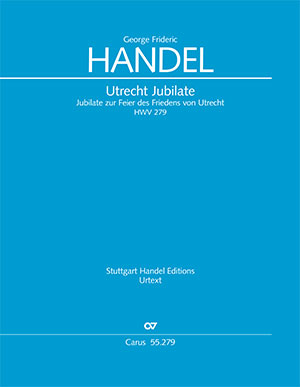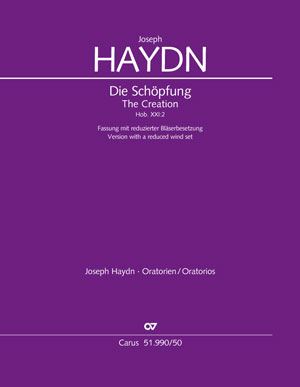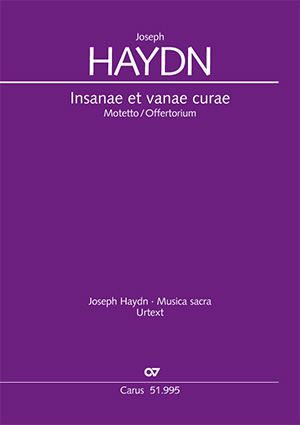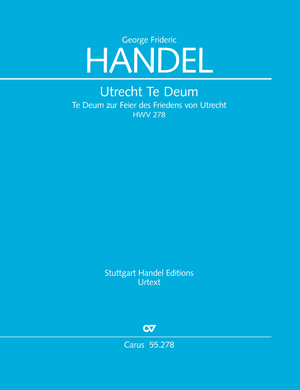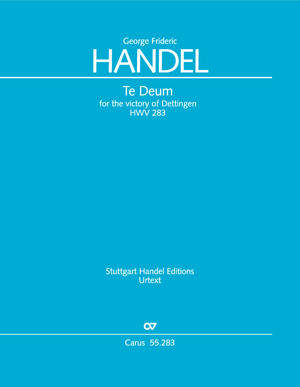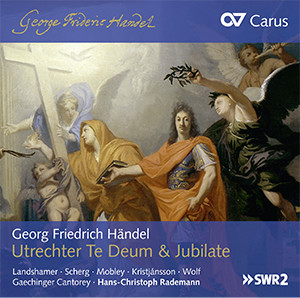Utrechter Jubilate
Psaume 100 HWV 279, 1713
Dès sa première représentation, l’Utrecht Jubilate HWV 279 de Händel suscite l’enthousiasme des auditeurs londoniens, et, en raison de ses larges possibilités d’utilisation, aujourd’hui encore celui des salles de concert et églises du monde entier. Il est donné pour la première fois le 7 juillet 1713 lors d’une cérémonie religieuse à la cathédrale Saint-Paul de Londres pour célébrer la paix qui a mis fin à la Guerre de Succession d’Espagne après douze années. L’Utrecht Te Deum and Jubilate sont les premières œuvres sacrées de Händel en anglais et ont été des étapes importantes au début de sa carrière londonienne.
Cette édition se base sur l’autographe de Händel (malheureusement incomplet) et sur une copie faite par l’entourage de Händel, qui va au-delà de l’autographe sur certains points et a livré des détails précieux. En 1717, Händel adapte le Jubilate pour un effectif moins important pour la chapelle à Cannons (HWV 246) et le fait précéder d’une sinfonia en deux parties, également reproduite en annexe de cette édition.
Le chœur est majoritairement à quatre voix, à huit voix seulement dans un court mouvement, le soprano est divisé dans deux autres mouvements. La deuxième partie d’alto solo peut aussi être assurée par un ténor aigu.
-
Compositeur
Georg Friedrich Händel
| 1685-1759George Frideric Handel put his exceptionally versatile compositional abilities to the test at an early age. After moving to London in 1712, where he was appointed Composer of Musick for His Majesty’s Chapel Royal in 1723, he wrote numerous masterpieces for the royal court as well as his major opere serie. For many years he enjoyed triumphant successes with his operas, which were sung by outstanding performers, with serenades, and later also with oratorios such as Saul and Israel in Egypt. Over the years Handel’s reputation grew far beyond the city where he worked; some of his choral works, particularly Messiah, have enjoyed a performance tradition which remains unbroken to this day, and are sung by choirs throughout the world. Plus d'information sur la personne
-
Éditeur
Uwe Wolf
| 1961Uwe Wolf studied musicology, history, and historical ancillary science at Tübingen and Göttingen. After receiving his doctorate in 1991 he was a research assistant at the Johann-Sebastian-Bach-Institut in Göttingen. From 2004 he worked at the Bach-Archiv Leipzig. There he directed a both research departments, was substantially responsible for the redisigning of the Bach Museum, and he developed the digital Online-Projekt Bach. Since October 2011 he has been the Chief Editor at Carus-Verlag, Stuttgart. He has taught at various universities and also belongs to the editorial boards of several complete editions. Plus d'information sur la personne
-
Éditeur de réductions pour piano
Andreas Gräsle
| 1964Andreas Gräsle (harmonium) studied church music in Stuttgart (organ: Jon Laukvik) and took his concert diploma in organ with Daniel Roth in Saarbrücken, followed by early music studies with Andrea Marcon. He was a scholarship holder of the German Academic Exchange Service (DAAD), and a prizewinner at the International Johann Pachelbel Competition in Nuremberg in 1991. From 1996 to 2003 he was choirmaster and organist at the Augustinuskirche in Schwäbisch Gmünd, and in April 2003 he became district choirmaster in Ditzingen. In addition, he is much in demand as chamber music partner, organist and harpsichordist. He has made several CDs of organ and chamber music, and his own improvisations and arrangements of children’s songs round off his musical activities. He has taught score reading at the Musikhochschule Stuttgart since 1997. Plus d'information sur la personne
-
Arrangeur
Paul Horn
| 1922-2016Paul Horn war ein deutscher Kirchenmusiker, Organist, Komponist und Musikwissenschaftler. Er studierte Kirchenmusik und Orgel an der Evangelischen Kirchenmusikschule Esslingen am Neckar bei Hans-Arnold Metzger und Musikwissenschaft, Theologie und Geschichte an der Universität Tübingen. Seine berufliche Laufbahn begann als Kantor an der Evangelischen Michaelskirche in Stuttgart-Degerloch. 1954 wurde er Kantor an der Evangelischen Stadtkirche Ravensburg, eine Position, die er bis zu seiner Pensionierung innehatte. Als Musikwissenschaftler arbeitete Horn bis ins hohe Alter eng mit Carus zusammen. So stammen zahlreiche Carus-Klavierauszüge aus seiner Feder. Plus d'information sur la personne
Critiques
…eine Freude für alle, die sich mit Händel beschäftigen.
Musik & Liturgie, 4/2022
... Mit seinen knapp 30 Minuten Aufführungsdauer, dem verhältnismäßig kleinem Orchesterapparat und den für Händel'sche Verhältnisse überschaubarem Einsatz von Koloraturen in den Chorstimmen bietet sich diese wunderbare Vertonung des 100. Psalms als idealer Einstieg in die oratorische Welt des großen Barockkomponisten an.
Andreas Peterl, singende kirche, 3/2021
... die Homophonie überwiegt aber deutlich und macht das Stück auch für nicht ganz so leistungsfähige große Chöre gut erreichbar. … gut für die Verwendung in einem Kantatengottesdienst geeignet.
Württembergische Blätter für Kirchenmusik, 05/2021
Questions fréquentes sur l'œuvre
est-ce vraiment judicieux de donner l’Utrecht Jubilate sans le Te Deum ?
comment les parties chorales sont-elles divisées ?
la partie solo avec deux altos et une basse est assez inhabituelle. Peut-on aussi faire autrement ?
cette édition est-elle compatible avec l’édition CV 10.179 plus ancienne ?
 Il n'y a pas encore de questions et réponses concernant cette œuvre ou vous n'avez pas trouvé la réponse à votre question sur l'œuvre ? Cliquez ici et envoyez votre question spécifique à notre service clients.
Il n'y a pas encore de questions et réponses concernant cette œuvre ou vous n'avez pas trouvé la réponse à votre question sur l'œuvre ? Cliquez ici et envoyez votre question spécifique à notre service clients.


